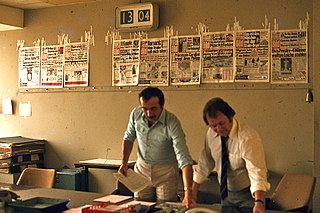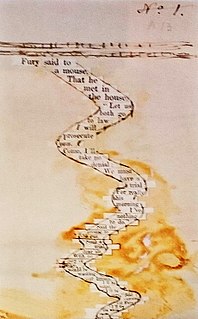In human–computer interaction and user interface design, cut, copy, and paste are related commands that offer an interprocess communication technique for transferring data through a computer's user interface. The cut command removes the selected data from its original position, while the copy command creates a duplicate; in both cases the selected data is kept in temporary storage. The data from the clipboard is later inserted wherever a paste command is issued. The data remains available to any application supporting the feature, thus allowing easy data transfer between applications.
A clipboard manager is a computer program that adds functionality to an operating system's clipboard. Many clipboards provide only one buffer for the "copy and paste" function, and it is overwritten by each new "copy" operation. The main task of a clipboard manager is to store data copied to the clipboard in a way that permits extended use of the data.

Phototypesetting is a method of setting type, rendered obsolete with the popularity of the personal computer and desktop publishing software, that uses a photographic process to generate columns of type on a scroll of photographic paper.
paste is a Unix command line utility which is used to join files horizontally by outputting lines consisting of the sequentially corresponding lines of each file specified, separated by tabs, to the standard output. It is effectively the horizontal equivalent to the utility cat command which operates on the vertical plane of two or more files.

Duncan Beiny, better known as DJ Yoda, is a hip hop turntablist who uses samples to create an animated musical style. He is known for several awards and media industry achievements.

News design is the process of arranging material on a newspaper page, according to editorial and graphical guidelines and goals. Main editorial goals include the ordering of news stories by order of importance, while graphical considerations include readability and balanced, unobtrusive incorporation of advertising.
Cut & Paste is a word processor published in 1984 for the Apple II, Atari 8-bit family, Commodore 64, IBM PC, and IBM PCjr. The few productivity releases from game developer and publisher Electronic Arts include this and Financial Cookbook. In the UK it was distributed by Ariolasoft.

The Nalayira Divya Prabandham is a collection of 4,000 Tamil verses composed by the 12 Alvars, and was compiled in its present form by Nathamuni during the 9th – 10th centuries. The work, an important liturgical compilation of the Tamil Alvars, marks the beginning of the canonization of 12 Vaishnava poet saints, and these hymns are still sung extensively today. The works were lost before they were collected and organized in the form of an anthology by Nathamuni.

In Hinduism, the tilaka is a mark worn usually on the forehead, sometimes other parts of the body such as neck, hand or chest. Tilaka may be worn daily or for rites of passage or special religious occasions only, depending on regional customs.
X-Acto is a brand name for a variety of cutting tools and office products owned by Elmer's Products, Inc. Cutting tools include hobby and utility knives, saws, carving tools and many small-scale precision knives used for crafts and other applications.

Paste up is a method of creating or laying out publication pages that predates the use of the now-standard computerized page design desktop publishing programs. Completed, or camera-ready, pages are known as mechanicals or mechanical art. In the offset lithography process, the mechanicals would be photographed with a stat camera to create a same-size film negative for each printing plate required.
Selections, cut buffers, and drag-and-drop are the mechanisms used in the X Window System to allow a user to transfer data from one window to another. Selections and cut buffer are typically used when a user selects text or some other data in a window and pastes in another one. Drag-and-drop is used when a user selects something in a window, then clicks on the selection and drags it into another window.
The clipboard is a buffer that some operating systems provide for short-term storage and transfer within and between application programs. The clipboard is usually temporary and unnamed, and its contents reside in the computer's RAM. The clipboard is sometimes called the paste buffer.
Control+C is a common computer command. It is generated by pressing the C key while holding down the Ctrl key on most computer keyboards.
A cut-and-paste job or cut and paste approach is a pejorative reference to various kinds of work produced by "cut and paste", i.e., a quick combination of pieces of text collected from various sources, a compilation.

Phanaeng, also spelled phanang, panang, and other variants) is a type of red Thai curry that is thick, salty and sweet, with a zesty kaffir lime flavour. The earliest known mention of phanaeng appears in Mom Somchin Rachanupraphan's book Tamra Kap Khao (ตำรากับเข้า), published in 1890.

iPhone OS 3 is the third major release of the iOS mobile operating system developed by Apple Inc., succeeding iPhone OS 2. It was announced on March 17, 2009, and was released on June 17, 2009. It was succeeded by iOS 4 on June 21, 2010; the new version dropped the "iPhone OS" naming convention. iPhone OS 3 was the last version to use the "iPhone OS" naming convention.
Perfect Writer is a word processor computer program published by Perfect Software for CP/M, subsequently rewritten and released as Perfect II by Thorn EMI Computer Software for IBM PC compatible computers. It was written in C and famous for its stability. It was an enhanced version of MINCE, which itself was a version of Emacs for microcomputer platforms. Emacs itself was too heavyweight to fit within the 64kb RAM limit of most microcomputers. Like MINCE, it included a floppy disk based virtual memory system.







